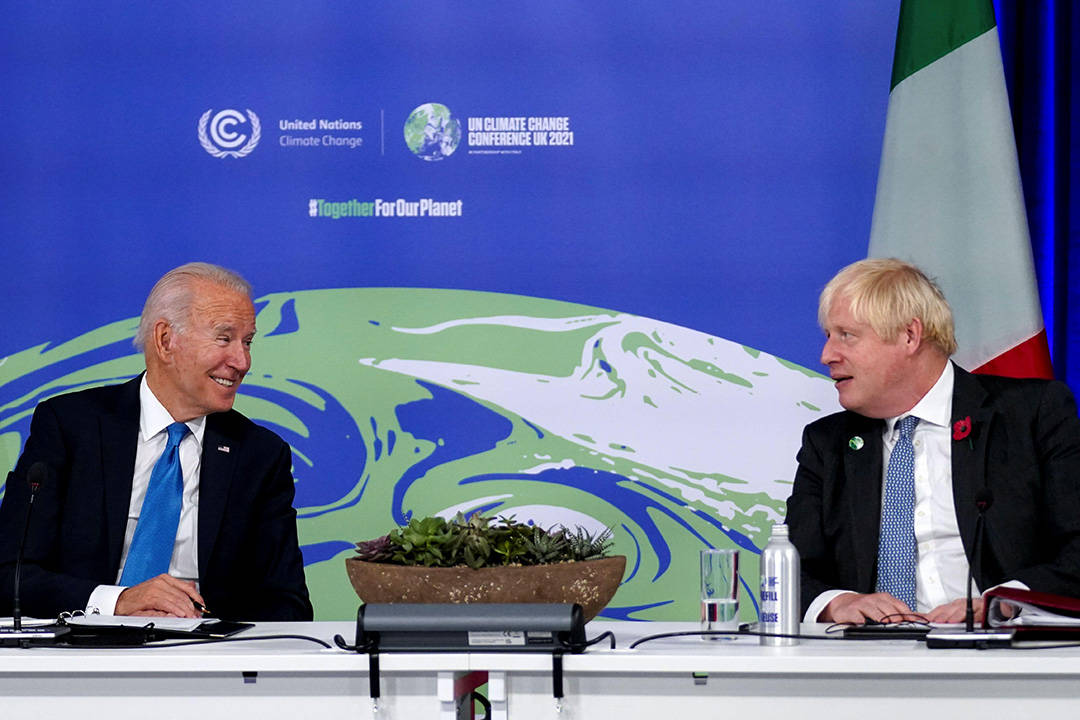Putin Makes the Case for the G7’s Clean Green Plan – Part 2
In the second of two articles, several potential strategies for financing the West’s clean green plan are set out.
The West’s clean green plan is promising. But it does not yet rise to the challenges posed by our warming planet – or the threats from Russia and China. It is not yet anything like a green version of the Marshall Plan, which the US funded after the Second World War to prevent Western Europe from sliding into the Soviet Union’s orbit. Nor is it yet on the same scale as what the EU did to bring Eastern European countries back into the democratic fold after the Cold War. It needs to be.
The clean green plan will only reach its potential if the West’s leaders make it a priority. It covers geopolitics, climate, trade, investment and aid, cutting across multiple government departments. Only leaders have the capacity to break down the silos and get their machines firing on all cylinders. But it is worth their while, because this plan is part of the answer to the strategic issues heightened by Vladimir Putin’s invasion of Ukraine – as well as helping save the planet.
The Group of Seven (G7) will achieve more if it is clearer about what it is trying to do. At the moment, US President Joe Biden sometimes sees the plan as a catch-all infrastructure initiative. It will achieve more if it is sharply focused on helping the Global South achieve fast and fair transitions to net zero.
Having different names – the US uses Build Back Better World (B3W), the EU Global Gateway and the UK Clean Green Initiative – does not help either. I like ‘Clean Green Plan’. But the exact name is less important than picking a single brand. The G7 will then be able to sing boldly from the same hymn-sheet and motivate all the relevant stakeholders: politicians across the world, policymakers, financiers, industrialists, international financial institutions, philanthropists and so forth.
The G7 should also think big. There is already a pipeline of countries, including Indonesia and Vietnam, that are interested in following South Africa. But to be transformational, the clean green plan needs to cover not just a few more countries, but the bulk of the Global South over the next few years.
Each partnership needs to be led by the country itself and tailored to that country’s specific needs. But the G7 also needs to be clear about what it is looking for: ambitious 2030 targets and net zero dates of around 2050.
Some developing countries will argue that 2050 is too much of a stretch. They rightly point out that they have not caused most of the emissions responsible for climate change, and it is not fair to keep them trapped in poverty.
But all governments signed up to COP26’s Glasgow Climate Pact, which called for net zero targets of ‘by or around mid-century’ and committed them to revisiting and strengthening their medium-term decarbonisation plans as necessary.
What is more, developing and emerging economies have a lot to gain from rapid transitions to net zero. Not only will they avoid the worst ravages of climate change, but hundreds of millions of people will gain access to electricity for the first time; millions of people will not die each year from air pollution; and their industries will be at the forefront of the next industrial revolution. Finally, with oil and gas prices soaring, switching to clean energy will save them money.
Turning Billions into Trillions
That said, the Glasgow Climate Pact also emphasised the need to take ‘different national circumstances’ into account – and clearly one of the most relevant circumstances for developing countries is that they do not have the resources to hit mid-century net zero targets. Many were suffering from debt loads even before the coronavirus pandemic. Now they have to cope with the higher food and fuel prices unleashed by the Ukraine crisis.
The G7 needs to be clear about what it is looking for: ambitious 2030 targets and net zero dates of around 2050
G7 leaders say they will scale up climate finance from ‘billions to trillions’ to fund their clean green plan. A good round-number guess is that the Global South, excluding China, will need $1 trillion a year for the rest of this decade to make the switch.
But how can the West mobilise such a large amount of money? This is 10 times the $100 billion a year in climate finance the rich countries promised to mobilise for developing countries by 2020 – and which they still have not delivered. What is more, they too are loaded up with debt from fighting the coronavirus pandemic – and their finances will take a further hit as a result of the Ukraine war. Some, notably Germany, are already planning huge hikes in defence spending.
But saving the planet from both climate change and bullies should be a priority. So, the West must find the necessary investment. What is more, if G7 countries think outside the box, they can make relatively small amounts of taxpayers’ money go a long way. They can tap capital from various sources that do not hit their budgets – private capital, guarantees and international financial institutions – and so turn billions into trillions.
The lion’s share of the investment must come from the private sector and go to private-sector projects. The plan is a huge opportunity for the West’s investors, companies and technologists to drive forward green industrial revolutions around the world by leveraging their entrepreneurial skills.
What is more, banks, insurance companies and pension funds in the West are under increasing pressure to align their activities with the Paris Agreement. Large numbers of them have joined the Glasgow Financial Alliance for Net Zero, which accounted for $130 trillion in assets by the time of COP26.
The snag is that little of this money is flowing to emerging and developing economies because the risks are too high. There are a variety of reasons for this, including bureaucracy, corruption and political risk. The result is that investment projects which would fly off the shelves in the West get stuck in developing countries.
A pincer movement can solve the problem. Developing countries can make themselves more attractive to private investment by cutting bureaucracy and corruption, ending fossil fuel subsidies, introducing carbon pricing, restructuring bankrupt power utilities, and so forth. Meanwhile, Western governments can absorb some of the remaining risks themselves.
Rich countries have traditionally helped developing countries through grants or cheap loans. But guaranteeing private investments – something the EU and UK are promising to do – will normally be a better bet. After all, this will by definition crowd in private capital.
Multilateral Multipliers
The West can also mobilise multilateral development banks (MDBs), led by the World Bank. These have huge expertise in dealing with developing countries but have not yet been adequately focused on climate change. Nor have they worked sufficiently with the private sector.
The plan is a huge opportunity for the West’s investors, companies and technologists to drive forward green industrial revolutions around the world
Routing funds through them can be extremely cost-effective. They operate on the principle of ‘callable capital’. This means their shareholders – the governments – put in a small fraction of their capital, with the rest supplied only if there are losses. What is more, MDBs can leverage their capital by borrowing and they, too, can crowd in private investors to work with them on common projects.
G7 countries now need to use their controlling shareholdings in most of the MDBs to give them a new climate-focused mission. They should also top up the capital of those institutions that show the most enthusiasm for the task.
A further source of funding which does not hit rich countries’ budgets is the IMF’s ‘special drawing rights’ (SDRs). These are the nearest thing there is to global money-printing. While SDRs are not cash, they can be converted into hard currency.
The IMF issued $650 billion in SDRs to its members last year as a response to the coronavirus pandemic. This followed the issue of $250 billion during the world financial crisis.
The snag is that most SDRs have gone to rich countries, which do not need them because they have their own hard currencies. The IMF is therefore working on a plan to channel $45 billion of rich countries’ excess SDRs into a trust to help countries build resilience to shocks, including from climate change. This is not nearly ambitious enough, however. The West should think of 10 times that number. After all, rich countries already have about $500 billion in SDRs that they do not need.
Critics may say there is no magic money tree. Even though guarantees, callable capital and SDRs do not hit government budgets immediately, they could do so in the future. These are so-called ‘off-balance sheet liabilities’. While this is true, they pale into insignificance compared to the off-balance sheet liabilities that the West is running by not tackling climate change decisively – and by reacting too late to the threat from China.
The West has the germs of a clean green plan for a clean green planet. It can win allies across the developing world to isolate Putin further and deter Beijing from throwing its weight around. It can also help stop climate change by funding the Global South to go green and prodding China to do so.
To reach its full potential, the West’s leaders need to drive their plan forward with gusto. Putin has given them reason to do so.
Missed Part 1? Read it here:
The views expressed in this Commentary are the author’s, and do not represent those of RUSI or any other institution.
Have an idea for a Commentary you’d like to write for us? Send a short pitch to commentaries@rusi.org and we’ll get back to you if it fits into our research interests. Full guidelines for contributors can be found here.
WRITTEN BY
Hugo Dixon
- Jim McLeanMedia Relations Manager+44 (0)7917 373 069JimMc@rusi.org



